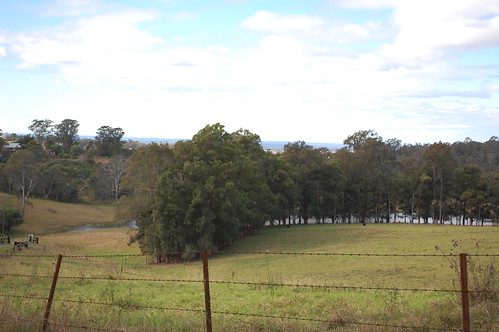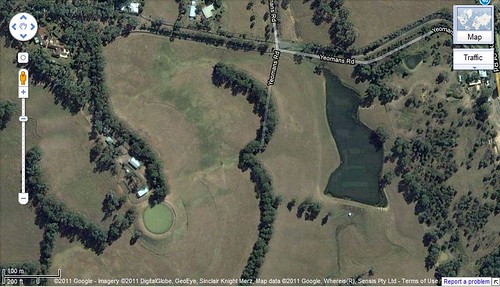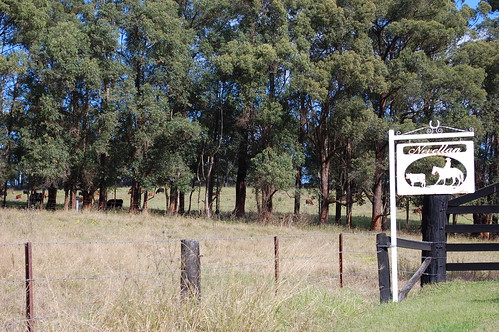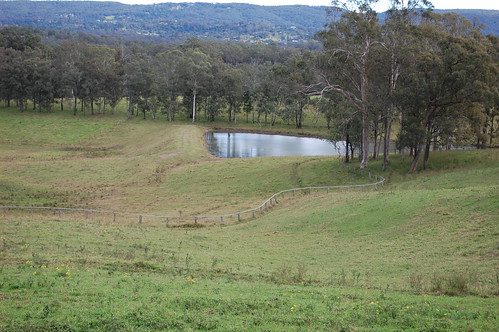
Today Ian and I embarked on our first adventure into Yeomans-land.
I took the train to Penrith, where Ian picked me up in his macho ute (6 wheels!), and we headed north to Nevellan. We didn’t really know what we’d do when we got there – and in fact, we didn’t really end up doing much at all. Just nosy-ing around really.
As we drove north, Ian filled me in. Nevellan was one of Yeomans’ experimental properties, where he tried out some of his Keyline farming techniques.
The Yeomans family doesn’t own the land any more – and I’d heard somehow that it was slated for redevelopment. But when we got there, we could see that it was still recognisable as having been seriously Yeomans-ised. Here’s a large dam at the bottom of the hill along Yeomans Road:
And here you can see a string of trees, just above the line of the dam:
On Google satellite, these treelines look quite striking:
The whole landscape had a friendly feel. I don’t know why. Maybe something about the rolling hills, the groomed lines of trees, the cheerful cows. We decided to push on up and visit the homestead, see if we could find out more.
Up the top of the hill, we found an old farmhouse. Nobody was there but a barking, harmless pooch. We drove on to the yard – still nobody. And then on the way back, we saw a ute approaching. Ian hopped out, and had a ute-to-ute chat with the farmer. Both men were about the same vintage.
Ian explained our project (such as it is, having hardly begun) – that we’re doing some research on Yeomans and his ways of designing landscape, and we’re going around checking out the old properties he’d worked on.
The farmer replied, “Yeah well you know of course we don’t do things the same way here any more”. He explained that the labour costs of farming in the Yeomans fashion made it impossible these days. “I use pumps and pipes to move the water round now.” The farmer agreed to meet with us for a bit longer, in a few weeks time, and show us around the land, “as long as you indicate on your website that it’s a private place. I don’t want hordes of people tramping up here.” We reassured him that we would pass that message along. The farmer’s name was Bob.
Here’s the view from the yard where Ian and Bob had their ute-chat (note the meandering fenceline):
We drove around a bit, but we couldn’t find any better vantage points – that will have to wait til our official visit with Bob. So we went up to the little town of Kurrajong to have some lunch.
* * *
While we ate, Ian and I talked about our own histories, our own relationships to the art world, how we ended up where we are now. Besides chasing Mr Yeomans, this chatting-with-each-other is another “keyline” of our project.
I guess the idea is to look into the intergenerational stuff surrounding this oddball brand of “conceptual art” that we do. I was surprised to find out how young Ian was in the early 1970s, how he was already exhibiting in the Sydney art scene when he was still in highschool. Talk about precocious. Oh, and he didn’t actually study art, formally speaking, but learned a lot from hanging around with the older artists at the Central Street Gallery, a key independent artspace in Sydney in the late 1960s.
I love this photo, which shows a young Steve Mori in a poster for a guest lecture by Ian Milliss at East Sydney Tech art school c.1971 (Ian would only have been 21 years old at the time!):
These days, Ian has a particularly cranky way of looking at the artworld. It’s a bit strange, because, as he says, when he was a teenager he was very keen to be a part of it all. But it didn’t take long before the politics of polite avant-garde object-making, upon which careers are made, annoyed him too much, and he turned to other, more direct methods for making changes in the world: squat activism, union communications and graphics. (To be honest, I still don’t really understand how it could be possible to see through the artworld’s machinations so critically, at such a young age.)
As to Ian’s current slow journey back to the artworld. How to make sense of it? Selling out? Going soft in his old age? I think Ian realises that the problems he identified with systems of art making and distribution, way back then, are still with us. But there are two ways of dealing with it. One is to turn your back on the whole thing and have nothing to do with it. The other is to take what you’ve got and head into the Heart of Mordor. (And in this Yeomans Project, I guess I’ll be Sam to his Frodo…)
And as for why various figures in the artworld are all of a sudden interested in Ian again, after 35 years out in the cold? Ian’s explanation is as follows:
“Well, as my wife Wendy says, I’m the biggest unrenovated house on the block.”
And with that real estate metaphor I will leave it, for now…






Leave a Reply to diego Cancel reply